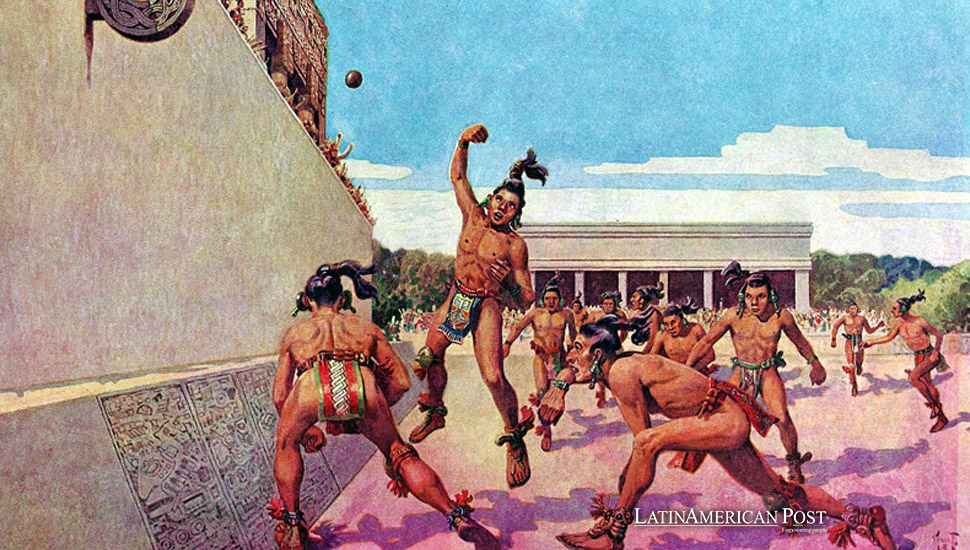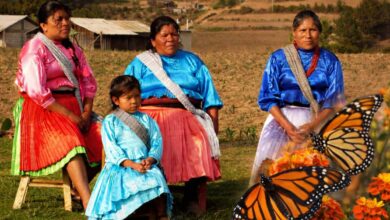Mexico’s Ancient Maya and Aztec Ball Games: Sacred Sports That Live On

The ancient ball games of Mexico’s Maya and Aztec civilizations were more than just sports—they were deeply spiritual rituals that connected players to the gods and the cosmos. As we learn more about these ancient practices, modern adaptations like ulama continue to preserve their legacy.
Thousands of years ago, the Mesoamerican ball game emerged as one of the most fascinating and complex sports in history, deeply woven into ancient Mexico’s religious and cultural fabric. While the Maya and the Aztecs played versions of the ball game, they each had unique interpretations and traditions.
For the Maya, the game was known as Pok-A-Tok and was played as far back as 1400 BCE. The game was more than a competition—a symbolic reenactment of the eternal struggle between life and death, chaos and order. The Maya believed that the game held cosmic significance, representing the constant battle between the forces of the underworld and the gods of the sky. According to Maya cosmology, the game’s results could even influence their daily lives, including fertility, harvests, and prosperity.
The Aztecs, on the other hand, called their version of the game Ōllamaliztli, which derived from the Nahuatl word “ōlli,” meaning rubber, in reference to the ball used in the game. Ōllamaliztli also played a crucial role in Aztec society, often serving as a religious ceremony to honor the gods, with the ball symbolizing the sun and the court representing the universe. For the Aztecs, the game held the power to communicate with the divine and ensure the continued balance of the cosmos.
Though these games were central to the cultural and religious life of both the Maya and the Aztecs, they were often bloody affairs. Human sacrifice, particularly among the losing players or even the victorious ones, was sometimes part of the ritual, underscoring the game’s connection to the spiritual world.
A Dangerous Sport Played for the Gods
Both Maya Pok-A-Tok and Aztec Ōllamaliztli involved intense physical competition. The ball used in these games was made from the sap of the native rubber tree, resulting in a solid, heavy sphere that could inflict serious injury on players. The goal of both games was to pass the ball through a stone hoop mounted on a wall without using the hands or feet. Instead, players relied on their hips, elbows, and knees to strike the ball.
The court where these games took place, known as a tlachtli in Aztec culture, was often located near temples and aligned with celestial events such as solstices and equinoxes. In both Maya and Aztec traditions, the ball court was seen as a sacred space, representing the universe itself, with the game serving as a metaphor for cosmic battles between the forces of light and dark, life and death.
While gameplay between the Maya and the Aztecs shared similarities, there were some regional variations in the rules. For the Maya, Pok-A-Tok was often played in front of large crowds, with the game sometimes lasting for hours or even days. The Aztecs, who had developed a more formalized version of the game, introduced ceremonial elements such as musical accompaniment and complex rituals surrounding the game.
The stakes of these matches were incredibly high. In some instances, losing a game could result in the players’ sacrifice, especially in the Aztec world, where offering a life to the gods was seen as an ultimate tribute. The Maya, on the other hand, associated the game with their mythological Hero Twins, Hunahpú and Xbalanqué, who were believed to have played a similar game against the gods of the underworld, ultimately triumphing over death.
The Sacred Role of the Ball Game in Mesoamerican Life
For both the Maya and the Aztecs, these ball games were closely tied to their religious practices. The ball court was not just a place for sport but a spiritual battleground where humans could communicate with the gods. Maya and Aztec mythology often referred to the game as a reflection of celestial movements, with the ball symbolizing the sun’s journey across the sky, or the ongoing fight between the forces of light and darkness.
In the Maya civilization, the ball game was directly connected to the Popol Vuh, the sacred book of the Maya, which recounts the tale of the Hero Twins. In the myth, the twins are summoned to the underworld by the gods of death, where they play a ball game as part of a larger cosmic battle. The twins’ eventual triumph over the gods symbolizes the victory of life over death and is linked to the Maya’s cyclical view of life, death, and rebirth.
Similarly, the Aztecs viewed Ōllamaliztli as a way to honor the gods and maintain the cosmic order. The Aztec sun god, Huitzilopochtli, was often invoked during the games, with the ball court serving as a microcosm of the universe. The belief was that the game could influence celestial forces, ensuring the continued passage of the sun across the sky and the fertility of the land.
Sacrifice was a key element in both cultures, and while it is uncertain whether it was the losers or the victors who were sacrificed, the ball game was often followed by human offerings to the gods. This ritualistic aspect underscores the significance of the ball game in Mesoamerican life, where physical prowess was seen as a reflection of divine will.
From Ancient Courts to Modern Ulama
With the fall of the Aztec and Maya civilizations following the Spanish conquest in the 16th century, both Pok-A-Tok and Ōllamaliztli began to disappear. The Spanish, who misunderstood the deep religious meaning behind the games, viewed them as primitive and banned them. In their eyes, the ball game was simply a form of gambling or entertainment, and the practice of human sacrifice further convinced them of the need to eradicate it.
Despite this suppression, the legacy of the Mesoamerican ball game has endured. Archaeological remnants of ancient ball courts have been found throughout Mexico and Central America, offering a window into the grandeur of these ancient games. The courts, often massive in scale, were constructed with impressive skill and precision, reflecting the importance of the game in Maya and Aztec society.
One modern-day version of the ancient ball game still survives today in parts of Mexico, known as ulama. Played primarily in the states of Sinaloa and Sonora, ulama closely resembles the ancient game, with players using their hips to hit a heavy rubber ball. While the game has lost much of its original religious connotations, its preservation represents a direct link to the pre-Columbian past.
Ulama serves as a reminder of the long-standing importance of ball games in Mesoamerican culture and offers a fascinating connection to the traditions of the Maya and Aztecs. The game has become a symbol of cultural resilience, with efforts being made to preserve and promote ulama as a living tradition that celebrates the history and heritage of Mexico’s indigenous peoples.
A Legacy of Sport, Spirituality, and Survival
The ancient Maya and Aztec ball games, Pok-A-Tok and Ōllamaliztli, were far more than mere pastimes. They were deeply spiritual rituals that connected players and spectators to the cosmic forces that governed their world. For the Maya, the ball game was a reenactment of the mythological battles of the Hero Twins, while for the Aztecs, it was a way to honor the gods and maintain the cosmic order.
Though the games eventually fell out of favor after the Spanish conquest, their legacy continues to influence both archaeology and modern culture. The discovery of ancient ball courts at Maya and Aztec sites highlights the central role these games played in the social and religious life of Mesoamerican civilizations. Meanwhile, the survival of ulama keeps alive the traditions of these ancient cultures, allowing modern-day players to engage in a game that once held the fate of civilizations in its hands.
As scholars continue to explore the history of Mesoamerican ball games, they uncover not just the details of an ancient sport, but the profound spiritual significance it held for the people who played it. Today, the ball game stands as a testament to the enduring cultural legacy of the Maya and Aztec civilizations, reminding us of the complex ways in which sports, religion, and society intertwine across time.




